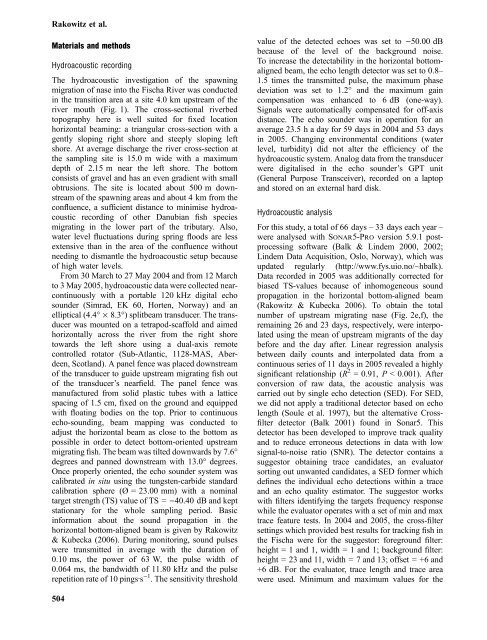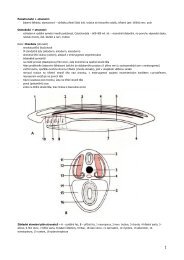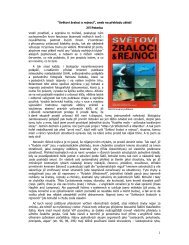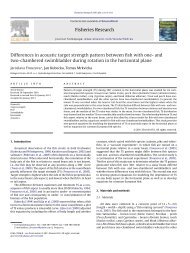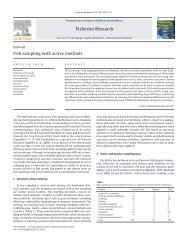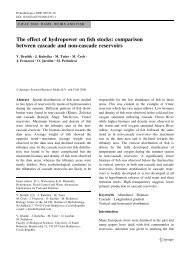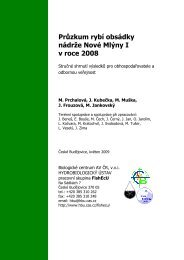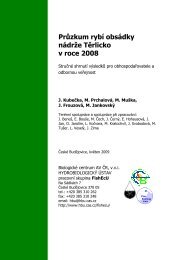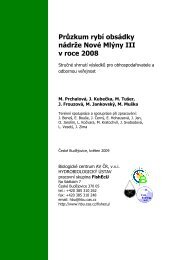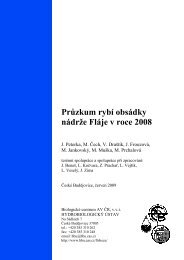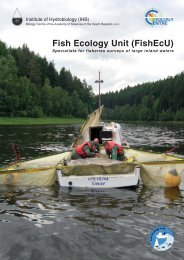Chondrostoma nasus - Biology Centre of the Academy of Sciences of
Chondrostoma nasus - Biology Centre of the Academy of Sciences of
Chondrostoma nasus - Biology Centre of the Academy of Sciences of
Create successful ePaper yourself
Turn your PDF publications into a flip-book with our unique Google optimized e-Paper software.
Rakowitz et al.<br />
Materials and methods<br />
Hydroacoustic recording<br />
The hydroacoustic investigation <strong>of</strong> <strong>the</strong> spawning<br />
migration <strong>of</strong> nase into <strong>the</strong> Fischa River was conducted<br />
in <strong>the</strong> transition area at a site 4.0 km upstream <strong>of</strong> <strong>the</strong><br />
river mouth (Fig. 1). The cross-sectional riverbed<br />
topography here is well suited for fixed location<br />
horizontal beaming: a triangular cross-section with a<br />
gently sloping right shore and steeply sloping left<br />
shore. At average discharge <strong>the</strong> river cross-section at<br />
<strong>the</strong> sampling site is 15.0 m wide with a maximum<br />
depth <strong>of</strong> 2.15 m near <strong>the</strong> left shore. The bottom<br />
consists <strong>of</strong> gravel and has an even gradient with small<br />
obtrusions. The site is located about 500 m downstream<br />
<strong>of</strong> <strong>the</strong> spawning areas and about 4 km from <strong>the</strong><br />
confluence, a sufficient distance to minimise hydroacoustic<br />
recording <strong>of</strong> o<strong>the</strong>r Danubian fish species<br />
migrating in <strong>the</strong> lower part <strong>of</strong> <strong>the</strong> tributary. Also,<br />
water level fluctuations during spring floods are less<br />
extensive than in <strong>the</strong> area <strong>of</strong> <strong>the</strong> confluence without<br />
needing to dismantle <strong>the</strong> hydroacoustic setup because<br />
<strong>of</strong> high water levels.<br />
From 30 March to 27 May 2004 and from 12 March<br />
to 3 May 2005, hydroacoustic data were collected nearcontinuously<br />
with a portable 120 kHz digital echo<br />
sounder (Simrad, EK 60, Horten, Norway) and an<br />
elliptical (4.4° ·8.3°) splitbeam transducer. The transducer<br />
was mounted on a tetrapod-scaffold and aimed<br />
horizontally across <strong>the</strong> river from <strong>the</strong> right shore<br />
towards <strong>the</strong> left shore using a dual-axis remote<br />
controlled rotator (Sub-Atlantic, 1128-MAS, Aberdeen,<br />
Scotland). A panel fence was placed downstream<br />
<strong>of</strong> <strong>the</strong> transducer to guide upstream migrating fish out<br />
<strong>of</strong> <strong>the</strong> transducer’s nearfield. The panel fence was<br />
manufactured from solid plastic tubes with a lattice<br />
spacing <strong>of</strong> 1.5 cm, fixed on <strong>the</strong> ground and equipped<br />
with floating bodies on <strong>the</strong> top. Prior to continuous<br />
echo-sounding, beam mapping was conducted to<br />
adjust <strong>the</strong> horizontal beam as close to <strong>the</strong> bottom as<br />
possible in order to detect bottom-oriented upstream<br />
migrating fish. The beam was tilted downwards by 7.6°<br />
degrees and panned downstream with 13.0° degrees.<br />
Once properly oriented, <strong>the</strong> echo sounder system was<br />
calibrated in situ using <strong>the</strong> tungsten-carbide standard<br />
calibration sphere (Ø = 23.00 mm) with a nominal<br />
target strength (TS) value <strong>of</strong> TS = )40.40 dB and kept<br />
stationary for <strong>the</strong> whole sampling period. Basic<br />
information about <strong>the</strong> sound propagation in <strong>the</strong><br />
horizontal bottom-aligned beam is given by Rakowitz<br />
& Kubecka (2006). During monitoring, sound pulses<br />
were transmitted in average with <strong>the</strong> duration <strong>of</strong><br />
0.10 ms, <strong>the</strong> power <strong>of</strong> 63 W, <strong>the</strong> pulse width <strong>of</strong><br />
0.064 ms, <strong>the</strong> bandwidth <strong>of</strong> 11.80 kHz and <strong>the</strong> pulse<br />
repetition rate <strong>of</strong> 10 pingsÆs )1 . The sensitivity threshold<br />
504<br />
value <strong>of</strong> <strong>the</strong> detected echoes was set to )50.00 dB<br />
because <strong>of</strong> <strong>the</strong> level <strong>of</strong> <strong>the</strong> background noise.<br />
To increase <strong>the</strong> detectability in <strong>the</strong> horizontal bottomaligned<br />
beam, <strong>the</strong> echo length detector was set to 0.8–<br />
1.5 times <strong>the</strong> transmitted pulse, <strong>the</strong> maximum phase<br />
deviation was set to 1.2° and <strong>the</strong> maximum gain<br />
compensation was enhanced to 6 dB (one-way).<br />
Signals were automatically compensated for <strong>of</strong>f-axis<br />
distance. The echo sounder was in operation for an<br />
average 23.5 h a day for 59 days in 2004 and 53 days<br />
in 2005. Changing environmental conditions (water<br />
level, turbidity) did not alter <strong>the</strong> efficiency <strong>of</strong> <strong>the</strong><br />
hydroacoustic system. Analog data from <strong>the</strong> transducer<br />
were digitalised in <strong>the</strong> echo sounder’s GPT unit<br />
(General Purpose Transceiver), recorded on a laptop<br />
and stored on an external hard disk.<br />
Hydroacoustic analysis<br />
For this study, a total <strong>of</strong> 66 days – 33 days each year –<br />
were analysed with Sonar5-Pro version 5.9.1 postprocessing<br />
s<strong>of</strong>tware (Balk & Lindem 2000, 2002;<br />
Lindem Data Acquisition, Oslo, Norway), which was<br />
updated regularly (http://www.fys.uio.no/~hbalk).<br />
Data recorded in 2005 was additionally corrected for<br />
biased TS-values because <strong>of</strong> inhomogeneous sound<br />
propagation in <strong>the</strong> horizontal bottom-aligned beam<br />
(Rakowitz & Kubecka 2006). To obtain <strong>the</strong> total<br />
number <strong>of</strong> upstream migrating nase (Fig. 2e,f), <strong>the</strong><br />
remaining 26 and 23 days, respectively, were interpolated<br />
using <strong>the</strong> mean <strong>of</strong> upstream migrants <strong>of</strong> <strong>the</strong> day<br />
before and <strong>the</strong> day after. Linear regression analysis<br />
between daily counts and interpolated data from a<br />
continuous series <strong>of</strong> 11 days in 2005 revealed a highly<br />
significant relationship (R 2 = 0.91, P < 0.001). After<br />
conversion <strong>of</strong> raw data, <strong>the</strong> acoustic analysis was<br />
carried out by single echo detection (SED). For SED,<br />
we did not apply a traditional detector based on echo<br />
length (Soule et al. 1997), but <strong>the</strong> alternative Crossfilter<br />
detector (Balk 2001) found in Sonar5. This<br />
detector has been developed to improve track quality<br />
and to reduce erroneous detections in data with low<br />
signal-to-noise ratio (SNR). The detector contains a<br />
suggestor obtaining trace candidates, an evaluator<br />
sorting out unwanted candidates, a SED former which<br />
defines <strong>the</strong> individual echo detections within a trace<br />
and an echo quality estimator. The suggestor works<br />
with filters identifying <strong>the</strong> targets frequency response<br />
while <strong>the</strong> evaluator operates with a set <strong>of</strong> min and max<br />
trace feature tests. In 2004 and 2005, <strong>the</strong> cross-filter<br />
settings which provided best results for tracking fish in<br />
<strong>the</strong> Fischa were for <strong>the</strong> suggestor: foreground filter:<br />
height = 1 and 1, width = 1 and 1; background filter:<br />
height = 23 and 11, width = 7 and 13; <strong>of</strong>fset = +6 and<br />
+6 dB. For <strong>the</strong> evaluator, trace length and trace area<br />
were used. Minimum and maximum values for <strong>the</strong>


